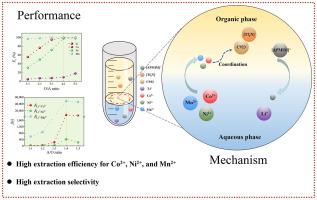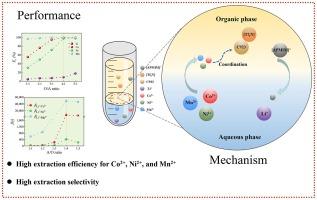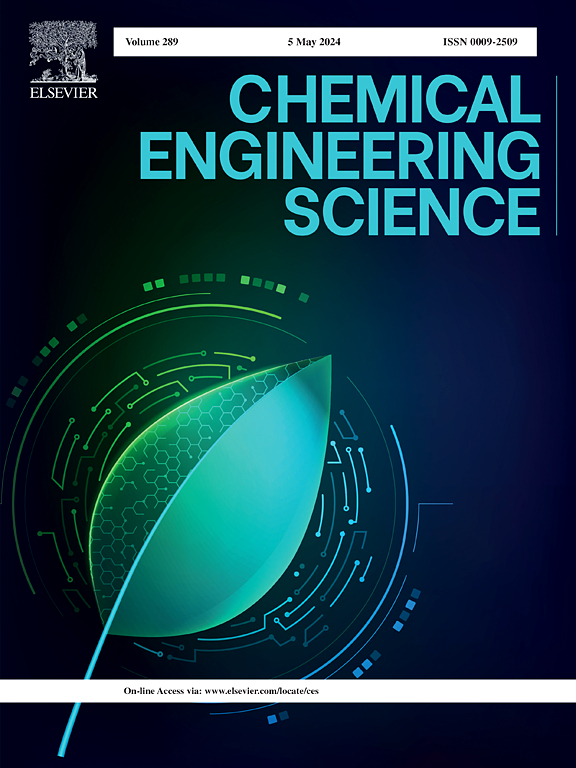基于离子液体从废旧锂离子电池中回收有价金属的实验和分子见解
IF 4.1
2区 工程技术
Q2 ENGINEERING, CHEMICAL
引用次数: 0
摘要
一种由离子液体(IL)1-氨基丙酰基-3-甲基咪唑鎓双((三氟甲基)磺酰基)亚胺([APMIM][Tf2N])和Cyanex 923(C923)组成的新型协同萃取剂首次被应用于从废锂离子电池(LIB)中选择性萃取有价金属。在最佳条件下,Co2+、Ni2+ 和 Mn2+ 的单级萃取效率分别高达 99.87 %、97.74 % 和 99.98 %,并在尾渣中富集了高纯度的 Li+。研究发现,萃取过程遵循所谓的 "阳离子交换机制",并通过量子化学(QC)计算揭示了分子水平的机制。研究结果表明,C923 与金属离子配位,IL 的阳离子将金属离子从水相交换到有机相,IL 的阴离子 [Tf2N]- 能将金属离子-[Tf2N]-C923 的复合物稳定在有机相中。这项工作为设计新型的基于 IL 的萃取剂提供了新的思路,有助于废锂电池的回收利用。本文章由计算机程序翻译,如有差异,请以英文原文为准。


Experimental and molecular insights into ionic liquid-based recovery of valuable metals from spent lithium-ion batteries
A new type of collaborative extractants consisting of the ionic liquid (IL) 1-aminoprooyl-3-methylimidazolium bis((trifluoromethyl)sulfonyl)imide, ([APMIM][Tf2N]) and Cyanex 923 (C923) is first applied for selective extraction of valuable metals from spent lithium-ion batteries (LIBs). The one-stage extraction efficiencies of Co2+, Ni2+ and Mn2+ are up to 99.87 %, 97.74 %, 99.98 %, respectively, at the optimal conditions, and the high-purity Li+ was enriched at the raffinate. It is found that the extraction process follows the so-called “cation exchange mechanism”, and the molecular-level mechanism is revealed via quantum chemical (QC) calculations. The findings show that C923 plays the role of coordinating with metal ions, the cation of IL exchanges metal ions from the aqueous to organic phases, and the anion [Tf2N]- of IL can stabilize the complex species of metal ion-[Tf2N]--C923 in organic phase. This work provides new insights for the design of novel IL-based extractants for the recycling of spent LIBs.
求助全文
通过发布文献求助,成功后即可免费获取论文全文。
去求助
来源期刊

Chemical Engineering Science
工程技术-工程:化工
CiteScore
7.50
自引率
8.50%
发文量
1025
审稿时长
50 days
期刊介绍:
Chemical engineering enables the transformation of natural resources and energy into useful products for society. It draws on and applies natural sciences, mathematics and economics, and has developed fundamental engineering science that underpins the discipline.
Chemical Engineering Science (CES) has been publishing papers on the fundamentals of chemical engineering since 1951. CES is the platform where the most significant advances in the discipline have ever since been published. Chemical Engineering Science has accompanied and sustained chemical engineering through its development into the vibrant and broad scientific discipline it is today.
 求助内容:
求助内容: 应助结果提醒方式:
应助结果提醒方式:


